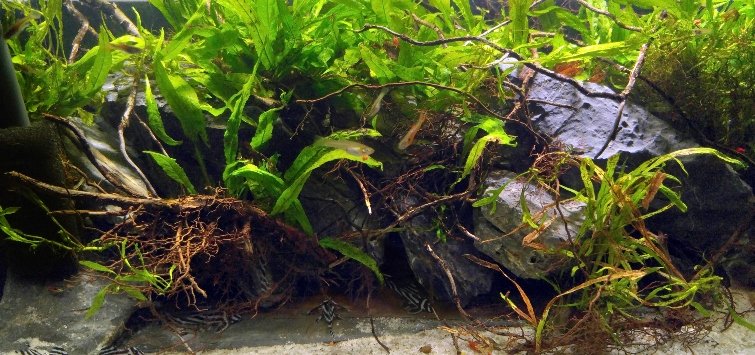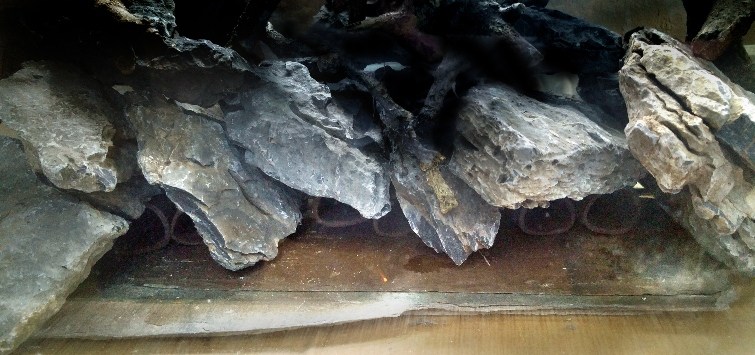How to Build a Zebra Pleco Habitat
Johnny Jensen
I know that I am not the only one who is fascinated by the zebra pleco (Hypancistrus zebra). It is an exceedingly rare and beautiful fish, with a price tag to match. And it is a fairly difficult fish to breed in captivity, a situation made even more urgent by the alarming fact that, with an incredibly limited and actively threatened range, the species is nearly extinct in the wild.
With all of this in mind, I started building my tank, in an attempt to approximate the natural conditions of this sublime fish’s habitat and hopefully encourage its breeding.
A Threatened Habitat
Unfortunately, the native habitat of the zebra pleco, the Xingú River in Brazil, is being dammed up, and it is feared that many species of fish endemic to this river will become extinct. This includes many Hypancistrus species, H. zebra among them.
The eminent Brazilian professor Leandro Sousa reports that local fishermen have tried to move these plecos to other Amazonian rivers with similar water characteristics but have so far been unsuccessful in making them breed there. With help from skilled breeders such as my Danish friend Frederik Christiansen, hopefully this plan will succeed in the future.
Zebra Plecos in the Wild
H. zebra has L-numbers assigned to it: L046 and L098. The L numbers are used to identify and separate plecos before they have been scientifically described. L stands for Loricariidae, the taxonomic family that includes the plecos, and the numbers indicate different collection locations and/or variations, such as physical appearance, stripes, and colors. In this case, L046 is the common form of the zebra pleco, and L098 is an uncommon form with wavy, broken lines.
These plecos can reach sizes of 2¾ to 4 inches (7 to 10 cm) in length. They normally reach breeding size at about 2 to 2½ inches (5 to 6 cm) and are known to breed all the way up to the ripe old age of 20 years. Sexing the fish is best done by observing from above; the females have a somewhat shorter and plumper shape than the males, and the males have broader and more powerfully contrasting stripes.
Wild-collected H. zebra specimens are found in shallow water of about 3 to 10 feet (1 to 3 meters) in depth. They tend to stay in the area of a particular rock in the river, which will be covered in sponges and the associated life forms, such as small crustaceans and worms, that provide the plecos with plentiful grazing. And the crevices under and between the rocks serve to protect them from pike cichlids (Crenicichla spp.) and other predators.
Zebras live in fast-moving, highly oxygenated currents, where the water is soft and has a pH of about 6 to 7 and a temperature of around 82° to 90°F (28° to 32°C).
It is a reasonable assumption that these plecos breed within the crevices of those rocks. However, nobody has reported seeing it happen. Without firsthand evidence, some have speculated that perhaps they breed more often in holes made by nesting birds in the muddy banks of the river. That would certainly explain the lack of evidence of zebra plecos breeding between the rocks. Again, these are just theories so far, but maybe such out-of-the-box thinking can help us better understand this fish.
Keeping and Breeding

For the rest of us, it is worth keeping in mind that zebras prefer places with some darkness to hide and engage in spawning activity, a fairly high temperature, a generous water flow, and frequent water changes. As for water hardness, the plecos have no problem with hard water from the tap, but if you want to breed them, it is best to use soft water.
The eggs tend to become harder from the calcium in hard water, which makes exiting the eggs more arduous, if not impossible, for the fry. Also, the babies that do come out can be snub-nosed from the exertion. This may be a mere cosmetic quirk to some aquarists, but I think it is well worth keeping in mind for the health of the fish.
There are several ways you can optimize the chances that your H. zebra will breed. Obviously, you need male and female fish to begin with; while it may sound unnecessary to even mention that inescapable fact, it can be a very real problem in that, by far, most fish sold in the ornamental fish trade are males. (At least that’s the case in Europe, and I suspect it holds true worldwide.) Also, it can be difficult for the untrained eye to distinguish between male and female specimens. And while you need one male and one female fish at a bare minimum, zebra pleco breeding is more likely to occur when you have several males, with a dominant male and a few subdominants, in addition to the female fish.
Apart from stocking the right sex ratio, dropping the temperature for a short period of time—though no lower than 77°F (25°C)—providing more frequent water changes, and even switching them to a specific food can trigger breeding. Certain granular foods targeted to discus and other Amazonian species have been known to do just that with several species of Hypancistrus.
The male takes care of the parental guarding of the eggs and young juveniles. If the juveniles have no hiding places outside their breeding cave, it is advisable to remove them to a separate tank or floating “fry box.” Otherwise, they run a high risk of being eaten by the adult plecos.
Juveniles are not even safe from their own mothers—females have been observed lying on top of a zebra pleco breeding cave and snatching up unwary juveniles exiting the safety of the enclosure.
My Zebra Tank

My fascination with these fish has led me to think about aquascaping. I wanted to create a seminatural space for them, something nice to look at, and (last, but not least) a great-looking environment in which to photograph them.
I took inspiration from images shown to me by my friend and coworker at Denmark’s Blue Planet Aquarium, Peter Petersen. Peter showed me pictures and video from the Xingú River depicting exactly what the river bottom topography looks like and where the zebras live. However, as interesting as it was to see underwater footage from the Xingú, I have to say that aquascaping my tank to look exactly like that environment would not only be fairly difficult to do 100-perecnt correctly, but also, ultimately, kind of boring.
I did keep in mind key points about the plecos’ habitat and habits. They prefer dark crevices, fast-moving water, plenty of oxygen, and high temperature, so I went about building up the aquascape using those guidelines.
First, I packed the rocks together, sloping along the direction of the water flow to direct as much current into the spaces between the rocks as possible. I placed the rocks on top of six separate pleco caves and a couple of layers of slate rock.
I used sand of varying grain sizes for the foreground and bottom material. The slate layers help the zebras easily sweep the sand away from the caves, which is apparently what they like to do.I placed the tank just under a window, as I very much like some natural light in the tank. But because the plecos prefer some dark areas, I covered the back of the tank up to about an inch (2.5 cm) from the top, leaving most of the rocks in relative darkness
I then attached the plants to the top of the rocks, and they seem to be thriving. I know there isn’t much plant life in the Xingú where the plecos live, and if there were, it certainly wouldn’t be narrow-leaf Java fern, but the plants are there for my own viewing pleasure as well as the natural benefits live plants confer to an aquarium.
For water quality, I make sure to change half the water at least once a week, using half reverse-osmosis water and half tap water. I keep the aquarium water temperature between 82° and 86°F (28° and 30°C). I feed them the granular discus food daily and some frozen foods once a week.
All Settled In
I have the tank right next to my home office workspace. Initially, I thought the plecos wouldn’t show themselves much because of my presence, but those worries were firmly put to rest once they settled in. They tend to stay near their covered caves, of course, but they are active and visible almost all of the time, even though I move about the room right in front of the tank.For such unique, beautiful fish, and especially because they are actively being threatened in their native habitat, creating and maintaining a setup dedicated to them is a labor of love. And I can think of no more deserving a fish for such special treatment than the regal zebra pleco.
The author would like to thank Frederik Christiansen, Peter Petersen, and Jools Dignall for their helpful knowledge and support during this project.
See the full article on TFH Digital
https://www.tfhdigital.com/tfh/may_jun_2018/MobilePagedReplica.action?pm=2&folio=52#pg55

.png?h=595&iar=0&w=2781&hash=5FD5E69473BCC22199FBFA2FB71B6033)



